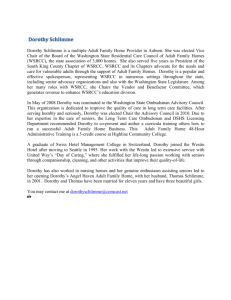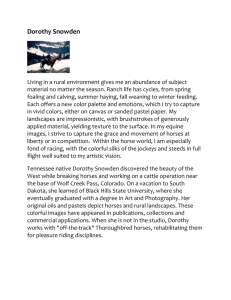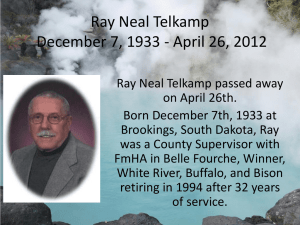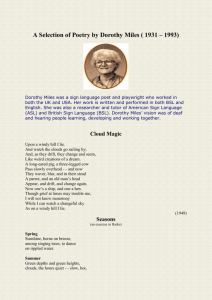Overview of Teaching Strategy The nursing process focuses on the
advertisement
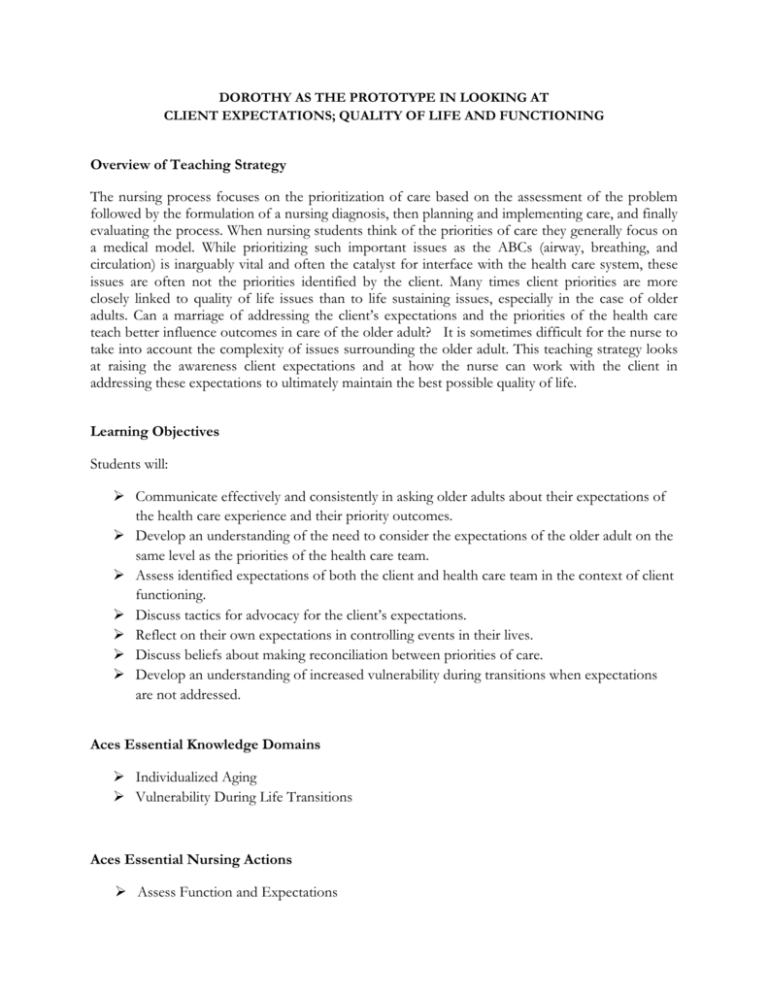
DOROTHY AS THE PROTOTYPE IN LOOKING AT CLIENT EXPECTATIONS; QUALITY OF LIFE AND FUNCTIONING Overview of Teaching Strategy The nursing process focuses on the prioritization of care based on the assessment of the problem followed by the formulation of a nursing diagnosis, then planning and implementing care, and finally evaluating the process. When nursing students think of the priorities of care they generally focus on a medical model. While prioritizing such important issues as the ABCs (airway, breathing, and circulation) is inarguably vital and often the catalyst for interface with the health care system, these issues are often not the priorities identified by the client. Many times client priorities are more closely linked to quality of life issues than to life sustaining issues, especially in the case of older adults. Can a marriage of addressing the client’s expectations and the priorities of the health care teach better influence outcomes in care of the older adult? It is sometimes difficult for the nurse to take into account the complexity of issues surrounding the older adult. This teaching strategy looks at raising the awareness client expectations and at how the nurse can work with the client in addressing these expectations to ultimately maintain the best possible quality of life. Learning Objectives Students will: Communicate effectively and consistently in asking older adults about their expectations of the health care experience and their priority outcomes. Develop an understanding of the need to consider the expectations of the older adult on the same level as the priorities of the health care team. Assess identified expectations of both the client and health care team in the context of client functioning. Discuss tactics for advocacy for the client’s expectations. Reflect on their own expectations in controlling events in their lives. Discuss beliefs about making reconciliation between priorities of care. Develop an understanding of increased vulnerability during transitions when expectations are not addressed. Aces Essential Knowledge Domains Individualized Aging Vulnerability During Life Transitions Aces Essential Nursing Actions Assess Function and Expectations Coordinate and Manage Care Make Situational Decisions NLN Competencies for Nursing Education Nursing Judgment Human Flourishing Spirit of Inquiry Click here to go to the NLN Competencies. Getting Started Listen to Dorothy’s monologue or read it here. What were Dorothy’s expectations of the hospitalization? What were the nurse’s expectations of the hospitalization? What is the connection between Dorothy’s expectations and her functioning? How does Dorothy define her quality of life? Do you agree? How could Dorothy’s transition be influenced by her expectations? What is the best way for the nurse to advocate for Dorothy? How is dignity considered when assessing Dorothy’s needs? What is the impact of immobility on Dorothy’s outcome? 1. Student reflection outlining expectations of health care, education, and relationships or a guided class or online discussion on expectations. Consider the following questions in initiating this exercise: What is most important to you? How have you felt when your expectations were not congruent with that of others? How have you felt when decisions were made for you? When was the last time you felt helpless? What is significant to you when you think of your quality of life? Given experiences that you have had in life, how have your expectations changed? 2. Utilize audience response questions to initiate a discussion on quality of life (see PowerPoint file in materials section 2). This format will allow students to answer questions anonymously. The ethical perspective of the questions will likely allow for rich discussions. They can be easily converted into any audience technology available. The questions in this audience response activity are as follows: The most important part of life is? a. Health b. Family c. Money d. Mobility If the quality of my life was diminished I would want to die – Yes or No Dorothy’s mobility should be the priority – Agree or Disagree I think the most important question to ask Dorothy is: a. “What is important to you?” b. “Have you fallen in the past three months?” c. “Do you want to live?” d. “So you feel your heart skipping a beat?” 3. A concept map is a diagram that illustrates relationships between concepts. Assign a concept map to students after they listen to the monologue or have the students do a concept map as a group project in class/seminar, or as a post-conference activity. See the example of the concept map in the materials section 3. This should be considered a draft. Have students start with this draft which uses decreased mobility as a concept and ask them to identify missing pieces and identify priorities of care while considering the essential nursing actions and essential knowledge domains. 4. Advanced Directives are written instructions regarding what actions an individual wants if they are unable to make decisions for themselves. In the monologue Dorothy talks about her expectations. Ask students to write their own advanced directives as an exercise to help raise their consciousness about quality of life issues and what measures they might want to sustain life in the face of illness or incapacity. This exercise lends itself to a discussion of their thoughts and decisions either in a verbal forum in person or an online forum in a discussion group. Materials 1. Consult GeriRN.org; the website of the Hartford Institute for Geriatric Nursing at New York University’s College of Nursing contains many evidence-based assessment tools. Those listed below from the Try This® and How to Try This Series® are particularly recommended for the content on geriatric syndromes. The tool, an article about using the tool, and a video illustrating the use of the tool, are all available for your use. The SPICES tool is listed first since it is an overall assessment tool; the remaining tools are listed in alphabetical order. Click here to view the list. Below is a suggestion of tools that may be appropriate in assessing Dorothy: Click here to go to ConsultGeriRN.org and the Try This® and How to Try This ResourcesSome examples of assessment tools that can be used with Dorothy are: Try This Issue 2 - Katz Index of Independence in Activities of Daily Living (ADL) Try This Issue 1- SPICES- An overall assessment tool of older adults Try This Issue 8- Hendrich Fall Risk Assessment Try This Issue 23- HARP Hospital Risk Admission Profile 2. Click onto this file which contains the PowerPoint slides that can be used for anonymous questioning with an audience response system as discussed as one of the activities in the Getting Started section. 3. Click onto this file which contains the draft of a sample concept map illustrating the concept of diminished mobility which can be used in the concept map activity outlined in the Getting Started section. Please note that this is only a sample and should be used as a draft and not considered a complete concept map related to the Dorothy case study. It includes missing pieces that students can add to in either an individual or group project. Suggested Readings NCBI Bookshelf. A service of the National Library of Medicine, National Institutes of Health. Hughes RG, editor. Patient Safety and Quality: An Evidence-Based Handbook for Nurses. Rockville (MD): Agency for Healthcare Research and Quality (US); 2008 Apr http://www.ncbi.nlm.nih.gov/books/NBK2629/?report=printable Historic ArticleOlson EV, Johnson, BJ, Thompson LF. The hazards of immobility. Am J Nurs. 1990 Mar; 90(3):43-8. 1967. PMID: 2178421. Boltz, M, Resnick, B, Capezuti, E, Shuluk,J, & Secic, M. Functional Decline o in Hospitalized Older Adults: Can Nursing Make a Difference? o Geriatric nursing (New York, N.Y.) 1 July 2012 (volume 33 issue 4 Pages 272-279 ) Author Information LaureenTavolaro-Ryley MSN, RN Community College of Philadelphia, PA lryley@ccp.edu
